
Payment hub security: Everything you need to know
This article is written by Nomentia Executive summary: As businesses handle more sensitive data and cross-border transactions, payment hubs have become essential for secure and efficient payment processes. Their security features mitigate fraud and operational risks, but continuous system strengthening is crucial to address evolving threats. In this blog post, Brian Hopkins, CISO at Nomentia with over 20 years of experience, discusses the challenges in modern payment activities and the security features of payment hubs and shares best practices for enhancing payment security, ensuring businesses can trust these systems to protect their financial operations. Meet our security expert Brian Hopkins, Chief Information Security Officer at Nomentia Brian is responsible for internal operations and processes at Nomentia, including information security, data privacy and corporate ICT. Brian has over two decades of experience in payment automation, including key roles in product delivery, product management, carve-out projects, HR and information security. Brian’s extensive experience and close customer co-operation have perfected his deep understanding of how cash management has evolved in organizations, from manual repetition to process automation and exception management. Security challenges in payment activities The top security concerns regarding payments are tied to their sensitive nature. These activities involve a series of financial data, including account details, customer information, and transaction amounts. This makes payments an attractive target for cybercriminals. According to AFP’s 2024 report, 80% of organizations reported falling victim to payment fraud, with nearly 40% recovering less than 10% of stolen funds. Any breach in security could result in compromised data, fraud, or disrupted financial operations. Based on the CIA model – Confidentiality, Integrity, and Availability, we can categorize the challenges related to payment activity security as follows: These security issues are becoming more challenging because payment systems are getting more complex, often working with outside vendors and moving toward instant payments. Different payment security threats and their impacts Companies should be aware of several security threats when conducting payment activities. Some of the most common risks include: When any of the threats occurs, the most immediate impact of fraud is financial loss, which can vary significantly based on the transaction size. In cases where large sums are targeted, such as breaches involving banks with hundreds of millions at risk, the financial damage can be serious. There is also the risk of reputational harm, which can be just as damaging. Smaller fraud attempts may go unnoticed for long periods, gradually causing substantial cumulative losses, although advancements in fraud detection systems have made these harder to execute. However, one-time, high-value frauds remain a significant concern despite these improvements. Why payment hubs are an ideal solution for secure payments Due to the critical nature of payment activities, businesses must carefully evaluate the systems they use to manage payments. While ERP systems and bank portals have long been popular, these solutions can pose challenges, particularly as a company’s financial infrastructure’s complexity grows. Many ERP systems have built-in bank connectivity, but each system often operates differently. This lack of standardization can lead to complex processes, especially for organizations using multiple banks or systems. Bank portals, on the other hand, offer limited functionality and rely heavily on manual processes, which increases the risk of errors and fraud. Payment hubs come in the picture as secure places for payment activities, protecting them effectively from common frauds. One of the main advantages of using a payment hub is the ability to harmonize the payment process across multiple systems and banks. The payment hub ensures that all payments follow the specific approval processes, such as the “four-eye principle” for approvals and integrates fraud prevention features. These features can detect duplicate payments or unauthorized changes to bank account details. Additionally, payment hubs often come with robust security features like encryption and fraud detection. Payment hubs offer several security features, as mentioned, but what exactly are they? And what companies should look for in a payment hub to ensure their payment activities are secure. We’ll explore these aspects further in the next section. Important security features of payment hubs To safeguard payment hubs effectively, the platform must combine technical solutions with secure processes. When choosing a payment hub from security perspective, businesses need to make sure the providers secure the following features for their solutions: Technical security features A payment hub’s technical security is foundational, ensuring that sensitive information is protected throughout the payment process. Usually, the technical features for security are covered in information security standards such as ISO/IEC 27001. Below are these must-have features: Process-related security features Beyond the technical aspects, payment hubs also require comprehensive processes to maintain security and operational efficiency. These process-related features ensure that all employees use the hub securely, especially in large organizations. Advanced fraud detection and prevention Fraud detection features are vital for any payment hub. They ensure that potentially fraudulent activities are identified and halted before they escalate. Business continuity and disaster recovery In addition to day-to-day security features, payment hubs should have a business continuity and disaster recovery plan to ensure that payment operations can continue even in the event of an outage or cyberattack. Emerging challenges and best practices for securing payment hub As payment hubs take on increasingly important roles in managing payments for growing businesses, they are encountering new challenges. Among them, Brian Hopkins highlights two key challenges: the rise of real-time payments and the growing complexity of financial systems. Growing challenges With real-time payments, the need for stronger security becomes even more critical. Once a payment is initiated, there is very little time to detect and reverse any fraudulent activity. For example, if a fraudulent cross-border transaction is processed, it can be nearly impossible to recover the funds, especially if the payment goes to a country with less stringent financial regulations. Additionally, as payment hubs become more interconnected with external financial partners, suppliers, and customers, the potential attack surface expands. This interconnectedness introduces more entry points for cybercriminals. A cyberattack on a third-party payment vendor could have a ripple effect, impacting the primary company and its operations. These challenges are just a few of the emerging issues businesses need to address when using payment hubs. While…
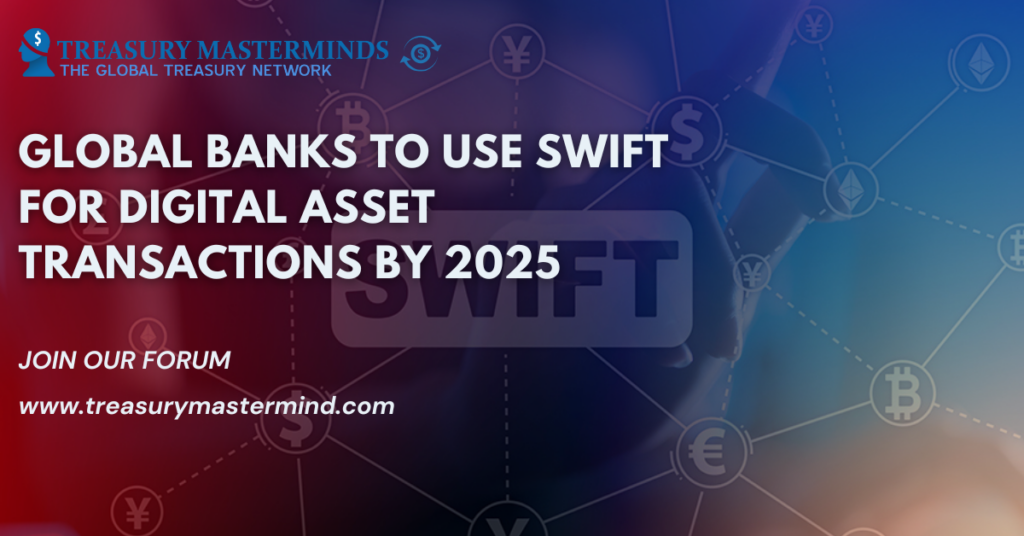
Global Banks to Use Swift for Digital Asset Transactions by 2025
The financial world is undergoing a transformation with the rise of digital assets and tokenization. And Swift is stepping in to facilitate this change. Starting in 2025, global banks will trial live digital asset transactions using Swift’s well-established messaging and infrastructure. This is an important step in creating a bridge between traditional finance and the rapidly evolving world of digital assets. Swift has long been a central player in global payments, ensuring secure and reliable cross-border transactions for financial institutions worldwide. With digital assets gaining traction—both in the form of cryptocurrencies and tokenized real-world assets—the need for a platform that supports the interoperability of these assets is growing. Swift’s initiative aims to meet that demand. Connecting Traditional Finance with Digital Assets One of the key challenges in integrating digital assets into mainstream finance is interoperability. Different platforms and blockchains often operate in silos, making it difficult for financial institutions to manage cross-border and cross-asset transactions. Swift’s approach, which leverages its messaging infrastructure, is to create a unified system for managing both digital and traditional assets. Earlier in 2023, Swift conducted a series of successful blockchain interoperability tests with global banks and financial institutions. These tests confirmed that Swift could enable digital asset transfers and ensure smooth communication between different platforms. The upcoming trials will take this a step further. This will allow banks to conduct live transactions using digital assets, all while connected to Swift’s network. Key Participants and Vision Prominent financial institutions, including BNP Paribas, Citi, and Clearstream, are taking part in the trials. These banks, along with other global players, will explore how they can integrate digital assets into their offerings. Whether it’s handling tokenized securities or settling digital currencies. Swift aims to be at the forefront of facilitating seamless financial transactions. This trial will provide valuable insights into how digital assets can coexist with the traditional financial system. Swift’s role will be to ensure that transactions are not only secure and compliant but also efficient. This is regardless of the asset being transferred. As more assets become tokenized—ranging from real estate to stocks—having a robust system like Swift’s that can handle these transactions will be crucial. What This Means for the Future The move towards digital assets is gaining momentum, driven by the potential benefits of tokenization. Tokenized assets, for instance, can enhance liquidity, make trading more efficient and open up new investment opportunities. Swift’s involvement signals that mainstream financial institutions are taking this seriously. For treasurers and finance professionals, this development could mean more efficient cross-border transactions, lower costs, and improved access to new asset classes. It’s a sign that the financial infrastructure of tomorrow will be more inclusive, supporting a wide range of assets and platforms without sacrificing the security and reliability that Swift is known for. Swift’s digital asset transaction trial is not just about adopting new technology; it’s about shaping the future of global finance. As tokenized assets and cryptocurrencies continue to grow, Swift is positioning itself as a key enabler, ensuring that both traditional and digital assets can be managed seamlessly in the same system. Conclusion The financial landscape is evolving, and Swift is making strides to ensure it remains relevant in a world where digital assets play an increasing role. With trials set for 2025, the global banking community will gain first-hand experience in managing digital assets, paving the way for broader adoption and integration of these assets into mainstream finance. Swift’s efforts to connect traditional and digital finance could be a major step forward for the global economy, offering new possibilities for financial transactions across borders and asset types. For financial professionals, keeping an eye on Swift’s developments in this area will be critical as the financial ecosystem continues to embrace the future of digital assets. Also Read Join our Treasury Community Treasury Masterminds is a community of professionals working in treasury management or those interested in learning more about various topics related to treasury management, including cash management, foreign exchange management, and payments. To register and connect with Treasury professionals, click [HERE] or fill out the form below. Notice: JavaScript is required for this content.
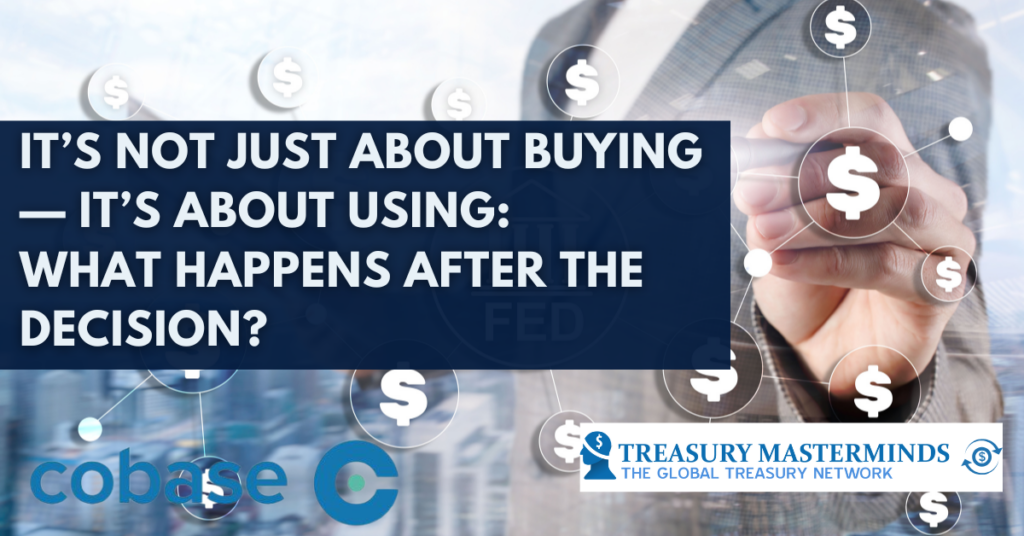
It’s not just about buying — it’s about using: What happens after the Decision?
This article is written by Cobase Choosing the right financial system for your business is a big deal, but the real challenge starts after you’ve made that decision. It’s easy to focus on picking the right solution, but what comes next—getting the system up and running, training your team, and making sure everything works smoothly—is where things can get tricky. The truth is, many businesses hit unexpected bumps in the road during this phase, from hidden costs to confusing setups. Let’s talk about how to avoid those pitfalls and why Cobase makes this process as seamless as possible. The reality of implementation After choosing your financial system, you face a new set of questions: How will the implementation be handled? Are you going to need external consultants, which can add extra costs? Will the solution provider manage the setup, or will your team need to take on some of the work? And importantly, what happens if something goes wrong—who’s responsible? These concerns are valid. In practice, many businesses discover that implementing a new system is more complicated than they expected. Some providers might require you to bring in expensive consultants to get the system running. Others might promise easy integration but struggle to deliver, leaving you to deal with unexpected delays and costs. Worse, when issues arise, it can be unclear who is accountable, leading to finger-pointing instead of solutions. Are you sure your provider can deliver? Here’s a critical question: Are you sure your provider has done this before? Implementing a financial system isn’t just about the software; it’s about knowing how to connect it seamlessly with your existing infrastructure. Many providers will assure you they can integrate with all your systems and banks, but the reality can be very different. Before you commit, challenge your provider. Have they successfully set up similar integrations before? Can they prove it? How quickly can they get you up and running, and do they have the experience to back up their promises? These are tough questions, but they’re essential to ask. The last thing you want is to discover halfway through implementation that your provider is in over their head. How Cobase keeps it simple and transparent At Cobase, we know that the success of your financial system isn’t just about making the right choice—it’s about ensuring everything works smoothly once you’ve made that decision. That’s why we’re committed to making the implementation process as straightforward and hassle-free as possible, with no hidden surprises. Support from day oneWhen you choose Cobase, you’re not left to figure things out on your own. We provide you with a dedicated project manager who guides you through every step of the implementation. We don’t rely on expensive external consultants—we handle everything in-house, ensuring your system is up and running on time and within budget. Our project manager is your single point of contact, so you always know who to turn to if questions or challenges arise. No hidden costsOne of the biggest concerns during implementation is the fear of hidden costs. Some providers might offer a low initial price but tack on charges for every additional feature, customization, or unexpected challenge. At Cobase, our pricing is transparent and straightforward. You only pay for the features you need, and there are no hidden fees. This means you can budget confidently, knowing there won’t be any surprises down the road. The integration landscape Integration is where many systems stumble. You’ve been promised seamless connectivity with your banks, ERP, and other systems, but how often does that promise hold true? With Cobase, we bring years of experience to the table. We’ve successfully integrated our platform with a wide range of banks and systems around the world. Our extensive library of pre-existing connectors means we can get you up and running quickly, without the need for extensive custom development. And if you have unique requirements, we have the expertise to handle them. Getting your team ready A financial system is only as good as the people using it. Even the most sophisticated system will fail if your team isn’t comfortable with it. Cobase understands this, which is why we make sure your team is well-prepared from day one. Our platform is designed to be intuitive and user-friendly, minimizing the learning curve. We also provide tailored onboarding and training to ensure everyone knows how to use the system effectively, helping you get the most out of your investment right from the start. Staying on track and on budget It’s a common story: a project starts strong but slowly drifts off course, eating up more time and money than planned. This is a risk with any major implementation, but at Cobase, we work hard to keep your project on track. We develop a clear plan with defined milestones, so you always know where you stand. Our approach is built around transparency and accountability, ensuring you stay within budget and meet your deadlines. Ongoing support you can count onYour financial system needs to keep evolving to stay effective. That’s why Cobase offers continuous support and maintenance. We handle all the updates and any issues that arise, so you don’t have to worry about them. Our support team is always ready to assist, ensuring your system remains efficient and reliable long after the initial setup. We’re here to make it work—no excuses At Cobase, we believe our job isn’t done until you’re fully operational and satisfied with how your system is performing. We’re committed to making the process as smooth and transparent as possible, with no hidden costs and no excuses—just a system that works the way you need it to. When you choose Cobase, you’re not just buying software—you’re partnering with a team that’s dedicated to your success. We’re here to ensure everything goes smoothly from day one, and we’ll be there to support you every step of the way. No excuses, just results. Money moves: 6 secrets of financial leaders The financial world is changing fast. To stay ahead, you need…
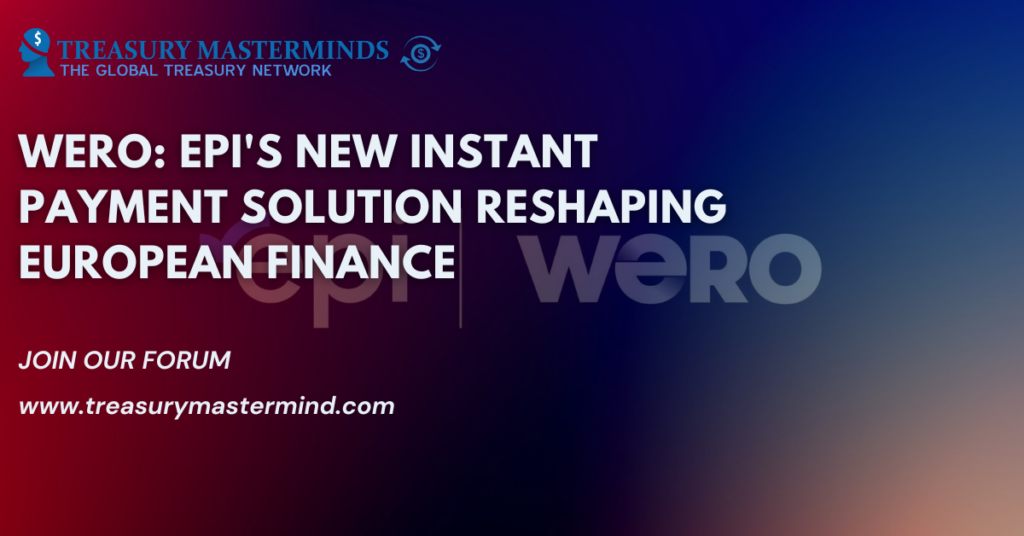
Wero: EPI’s New Instant Payment Solution Reshaping European Finance
The European Payments Initiative (EPI) has taken a significant step towards unifying the European payment landscape with the launch of Wero, an innovative instant payment solution. This new service, currently available in France, is backed by major banks, including BNP Paribas, Crédit Agricole, and Crédit Mutuel. As Wero begins to make its mark on the European financial sector, it’s worth exploring its current features, future aspirations, and the broader implications for the continent’s payment ecosystem. Key Features of Wero Wero simplifies peer-to-peer transactions by allowing users to send and receive money instantly using just an email address or phone number. This streamlined approach eliminates many of the complexities associated with traditional banking transactions. Set to replace Paylib by 2025, Wero is positioning itself as an all-in-one payment solution. Its functionality is expected to expand beyond personal payments to include: This versatility will enable users to conduct a wide variety of transactions seamlessly, whether online or in-store. Bolstering Europe’s Financial Sovereignty One of the primary objectives of Wero is to strengthen Europe’s financial sovereignty. Historically, the region has relied heavily on international payment processors like Visa and Mastercard for cross-border transactions. By establishing Wero, EPI aims to create a secure, efficient, and European-controlled payment system. This initiative is expected to reduce dependence on non-European players and promote smoother cross-border transactions within the region. Benefits for Businesses Wero also aims to enhance the payment experience for businesses, particularly small and medium-sized enterprises (SMEs). The instant payment features allow retailers to access funds immediately, which can significantly improve cash flow and liquidity. This speed is crucial for smaller merchants who often depend on quick access to their earnings to maintain operations. Part of a Broader Vision Wero is part of EPI’s broader vision to simplify payments across Europe, addressing the challenges of fragmentation and fostering financial inclusion. The platform aligns with the European Union’s initiative to develop a more cohesive and secure financial infrastructure, positioning itself as the primary digital wallet for everyday transactions. Future Aspirations and Ultimate Goals While Wero is currently operational in France, its ambitions extend far beyond. The EPI has outlined several key aspirations for the future of Wero: Challenging the Status Quo One of the ultimate goals of Wero and the EPI is to provide a viable European alternative to the dominant Visa and Mastercard schemes. This ambition is driven by several factors: Challenges and Opportunities The road ahead for Wero is not without challenges. Achieving widespread adoption across diverse European markets, each with its own established payment habits and systems, will require significant effort and investment. Moreover, competing with well-entrenched global players like Visa and Mastercard, who have decades of experience and vast networks, is a formidable task. However, these challenges also present opportunities. The fragmentation of the European payment landscape means there’s significant room for improvement and efficiency gains. Wero’s success could lead to: Looking Ahead As Europe continues to move towards greater digitalization and real-time financial services, Wero is poised to be a transformative player in modernizing the payment landscape. It offers individuals and businesses a streamlined, efficient, and secure way to manage their transactions in a rapidly changing digital economy. The success of Wero could mark a significant shift in how Europeans conduct financial transactions, potentially reshaping the continent’s financial ecosystem for years to come. As it evolves and expands, Wero may well become a cornerstone of European financial sovereignty and a symbol of the EU’s capacity for technological innovation and economic integration. The journey of Wero is just beginning, but its potential impact on European finance is immense. As it grows and develops, it will be fascinating to watch how this ambitious project shapes the future of payments in Europe and beyond. Also Read Join our Treasury Community Treasury Masterminds is a community of professionals working in treasury management or those interested in learning more about various topics related to treasury management, including cash management, foreign exchange management, and payments. To register and connect with Treasury professionals, click [HERE] or fill out the form below. Notice: JavaScript is required for this content.
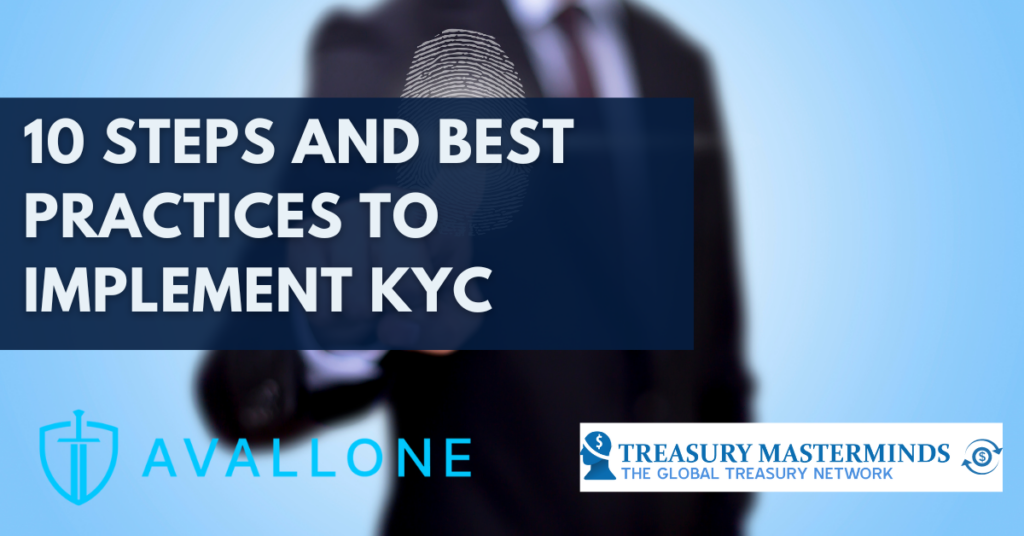
How to get started with implementing KYC: Ten steps and best practices
This article is a contribution from one of our content partners, Avollone Implementing Know Your Customer (KYC) procedures is essential for businesses operating in industries with products that are more likely to be used for financial crime, trading in countries and areas with sanctions, counterparties that increase the financial crime risk, or companies there regulated by AML / CTF regulation. KYC helps prevent financial crimes, protect the company’s reputation, and ensure compliance with regulatory standards. If you’re looking to get started with KYC, here are ten steps to guide you through the process. Step 1: Understand regulatory requirements and your own risk The first step in implementing KYC is to understand the regulatory requirements relevant to your industry and region. Different countries have varying regulations concerning KYC and anti-money laundering (AML) practices. Research the specific laws and guidelines that apply to your business. This understanding will help you design a KYC process that meets legal standards and avoids potential fines or penalties. As a non-regulated company, it is very helpful to implement KYC using regulatory principles. This ensures that you meet the expected standards from your counterparties and makes it easier to explain it to them. It also increases the likelihood of designing an effective KYC process. Another key component of this first step is that you need to understand what risk you are trying to mitigate before you design your policy. The best approach would be a Risk Assessment, where you would systematically identify, evaluate, and manage risks that are likely for your business—in particular, the ones that would be potentially hazardous or negatively impact your organization. Step 2: Define your KYC framework and policies Once you are familiar with the regulatory requirements, the next step is to define your KYC framework and policies. A KYC framework is based on various levels of documentation. The starting point for the Framework is the Financial Crime Risk Assessment, which we have referenced in the previous step. If it hadn’t been completed yet, then it should be done first to identify the inherent risks that the company is exposed to and must mitigate. Based on the risk assessment, then a number of policies will be created which outline how the risks must be mitigated, and the roles and responsibilities which define who should do what across the organization. The procedures, guides, and templates are the practical implementation that make up this framework of how to comply with the company’s Kyc and financial crime prevention program. Your KYC policy should outline the objectives, scope, and requirements for KYC, screening, and assessing the counterparty risk. It should also detail the roles and responsibilities of employees involved in the KYC process. A well-defined policy serves as a blueprint for your KYC implementation and ensures consistency across your organization. Step 3: Design the KYC process Designing the KYC process involves mapping out the steps your company will take to verify customer identities and monitor their activities. This process typically includes: Most companies will also build the sanctions, PEP, and adverse media screening into the KYC process. An effective screening process depends on quality KYC data, and the screening result is important for the counterparty risk assessment. Step 4: Select and implement the tool / technology that best supports your KYC needs Implementing KYC manually can be time-consuming and prone to errors. Selecting the right technology solutions can streamline the process and enhance accuracy. Look for KYC software that offers features like automated data collection, identity verification, risk assessment, and transaction monitoring. Ensure that the technology is scalable and compliant with relevant regulations. A tool should also make it easier to design your KYC process (step 3) since it should come with helpful workflows. Step 5: Train and educate your team Effective KYC implementation requires knowledgeable and vigilant staff. Provide comprehensive training to employees involved in the KYC process. Training should cover the importance of KYC, regulatory requirements, your company’s KYC policy, and how to use the selected technology tools. Ensure that your staff is trained to recognize red flags and understand the reporting protocols. Regular training sessions should be conducted to keep staff updated on the latest trends and regulatory changes. Step 6: Get started with your KYC as soon as you can One of the most important of all the steps is to just get started. The previous steps are important as they provide you with the overall approach, strategy, and procedure for your KYC, but all the planning in the world will not be useful if implementation is not started. So, we strongly recommend that as soon as you can, start collecting and verifying your counterparties’ information—and then assess and document their risk levels within your selected tool. Remember, even if the above steps seem very comprehensive, it is better to start small and mature as you gain more insight into your risk and process. The most effective control is the one that has been implemented. Step 7: Clear Escalation Process with Identified Suspicious Activities Part of an effective KYC process is the ability to detect, review and escalate suspicious activities, so establish clear internal processes for the reporting within your organization of such activities. Prompt and accurate analysis and escalation with concerning, suspicious or unusual behavior with your counterparties is crucial when it comes to compliance and preventing financial crimes. Step 8: Maintain Accurate Records Accurate record-keeping is a crucial aspect of KYC compliance. Ensure that all customer information and data are meticulously documented and securely stored. Maintaining thorough records not only helps in audits and regulatory reviews but also supports internal investigations and risk assessments. With the right tool and technology, it can serve as your reliable data management system to handle and protect these records, ensuring they are easily accessible when needed, while still meeting GDPR and other privacy requirements. Step 9: Foster a Culture of Compliance Creating a culture of compliance within your organization is essential for the success of your KYC program. This involves promoting awareness of the importance of KYC and AML…

Top 10 Recent Books Corporate Treasurers Should Read for Real-Life Lessons
In today’s fast-paced finance and treasury landscape, staying informed and drawing insights from real-world events can help corporate treasurers navigate complexity and uncertainty. Beyond theoretical knowledge, the stories behind financial markets, corporate collapses, frauds, and innovations offer valuable lessons. These narratives not only inspire but also serve as cautionary tales for professionals in treasury and finance. Here’s a curated list of the top 10 Treasury management books, featuring gripping real-life accounts of financial revolutions, scandals, and innovations. Each book provides insights into risk management, corporate governance, market dynamics, and the evolving role of treasury in a rapidly changing world. 1. Trillions: How a Band of Wall Street Renegades Invented the Index Fund and Changed Finance Forever 2. The Billionaire’s Apprentice: The Rise of The Indian-American Elite and The Fall of The Galleon Hedge Fund 3. Black Edge: Inside Information, Dirty Money, and the Quest to Bring Down the Most Wanted Man on Wall Street 4. Bad Blood: Secrets and Lies in a Silicon Valley Startup 5. Kleptopia: How Dirty Money is Conquering the World 6. The Man Who Solved the Market: How Jim Simons Launched the Quant Revolution 7. The Bond King: How One Man Made a Market, Built an Empire, and Lost It All 8. Capitalism in America: A History 9. The Cult of We: WeWork, Adam Neumann, and the Great Startup Delusion 10. Money Men: A Hot Startup, A Billion Dollar Fraud, A Fight for the Truth Let’s Grow the List Together! These 10 books offer a wealth of real-life lessons that treasurers can apply to their daily roles—from managing risk and governance to understanding markets and innovation. But this is just a start. Have you come across any other real-life story-based books that offer treasury or finance lessons? We invite you to share your recommendations in the comments and help us build an even more comprehensive reading list for treasury professionals! By sharing this list, we hope to spark a dialogue within our treasury community. Feel free to suggest your favorite reads or comment on which of these books have had the biggest impact on your professional development. Also Read Join our Treasury Community Treasury Masterminds is a community of professionals working in Treasury Management or those interested in learning more about various topics related to Treasury Management, including cash management, foreign exchange management, and payments. To register and connect with Treasury professionals, click [HERE] or fill out the form below. Notice: JavaScript is required for this content.
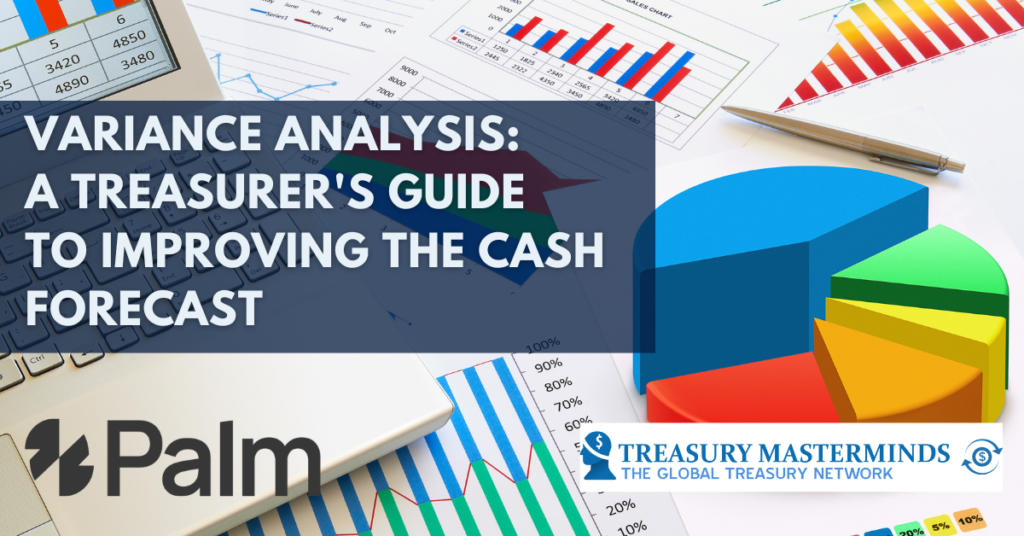
Variance Analysis: A Treasurer’s Guide to Improving the Cash Forecast
This article is written by Palm A cash flow forecast without variance analysis is like an employee operating without any feedback. Their opportunity to learn, grow, improve and iterate is forgone and they are blind to how well they are performing. Despite this, many treasurers choose not to expend their scarce resources running a regular and comprehensive variance analysis. Is it because they struggle to step off the metaphorical treadmill, which involves constantly updating and managing the cash forecast, without leaving time to look back over past performance? Or is it simply, that they don’t have the insight into the variances, and the visibility to be able to understand and take action to correct differences? TreasuryWhatever the reason may be, in this blog post we’ll explore its importance, discuss why businesses often miss out on its benefits, and introduce Palm, a tool that revolutionises variance analysis, giving it life and making daily variance analysis a valuable tool in the treasury toolkit. What is Variance Analysis? Variance analysis is a powerful financial analysis tool used to measure the difference between forecasted and actual financial performance. It involves both quantitative and qualitative assessments to provide a comprehensive understanding of financial discrepancies. Quantitative analysis focuses on the numerical differences, while qualitative analysis provides explanations and reasons behind these variances. Calculated as: For incoming amounts: Actual cash flow – Forecasted cash flow For outgoing amounts: Forecasted cash flow – Actual cash flow This ensures the variance is identified correctly as either positive or negative. If the forecasted income is lower than expected, this is a negative variance, whereas if forecasted costs are lower than expected, then this is a positive variance. By identifying and analysing these differences, we as treasurers can pinpoint areas for improvement, make adjustments, and enhance the effectiveness of the forecast. However, not all variances are created equally. A 100% variance in a small bank account or category may have little impact on the overall forecast, whereas a 5% deviation in the largest bank account could deem the forecast as unreliable. Therefore when doing this process, it is key to focus on correcting the differences that will have the largest impact. Why is Variance Analysis Important? The significance of variance analysis cannot be overstated. However, we find larger corporations often overlook variance analysis due to the complexity involved in preparing the forecast and having detailed knowledge of the underlying positions to take corrective action. And in doing so, are missing out on these key benefits: 1. Enhances Financial Accuracy Regular variance analysis ensures that financial forecasts are accurate and reliable. By comparing actual results with forecasts, businesses can identify deviations and adjust future predictions accordingly. This leads to more precise budgeting and financial planning. 2. Identifies Changes in the Business As much as treasurers try to stay in the loop, there can be situations when the treasurer is unaware of a significant change which impacts the cash forecast and until variance analysis is conducted, they do not understand the impact. A timely variance analysis can bridge these gaps and improve overall efficiency. 3. Facilitates Strategic Decision-Making Variance analysis provides valuable insights that inform strategic decision-making. Understanding the reasons behind financial variances can prevent such instances from occurring again in the future. Introducing Palm: Revolutionising Variance Analysis Palm has dedicated much time and energy to creating a variance analysis tool, designed to cut through the noise and direct your attention to areas where you can add the most value. Streamlined Focus When using Palm each day and working with your cash management and positioning, your attention will be directed to the Notable Activities section of the cash flow dashboard. This is where Palm highlights Palm highlights the variances you need to investigate. This targeted approach allows for quick identification and resolution of financial discrepancies. Easy Investigations Investigating variances has never been easier. With Palm, you can drill down from the cash flow into individual transactions and corresponding bank statements. This seamless integration simplifies the investigation process, enabling you to quickly identify the root cause of variances and take corrective action. Continuous Improvement Palm’s learning capabilities ensure continuous improvement of your forecasts. By feeding back insights from variance analysis into the predictive models, Palm helps train these models to become more accurate over time. This means you can transfer your knowledge and expertise into Palm, allowing it to benefit your team and future members too. Real-Time Variance Analysis for Proactive Decisions One of the key advantages of Palm is its ability to integrate variance analysis into the daily operations of the treasury team. Instead of being a retrospective process, variance analysis becomes an ongoing activity, providing real-time insights that drive proactive decision-making. Staying Ahead of Issues With real-time variance analysis, you can identify and address issues as they arise, rather than waiting until the end of the month. This proactive approach ensures that potential problems are resolved quickly, minimising their impact on the business. Improving Forecast Accuracy By continuously iterating and updating forecasts based on real-time variance analysis, Palm helps improve the accuracy of your financial predictions. This leads to more reliable forecasting and financial planning, enhancing overall financial performance. Empowering Your Team Palm’s intuitive interface and advanced features empower your team to take ownership of variance analysis. By making this critical process more accessible and manageable, Palm helps your team become more efficient and effective in their roles. The Palm Advantage Variance analysis is one of the many tools available in Palm that differentiates the system from incumbent providers. A platform designed by treasurers for treasurers, it is a joy to use, and can add value from day 1. Here are some of the key benefits of using Palm in your treasury: Advanced Predictive Models Palm’s predictive models, generate a cash flow forecast using your data, which continuously improves over time learning your business and your business insights. As you investigate and correct your variances, we replicate these changes in the future, if you want us to. User-Friendly Interface Palm’s user-friendly…

Bitcoin’s $66,000 Milestone: What It Means for Corporate Treasurers
The Bitcoin Boom Bitcoin has once again captured headlines, soaring to $66,000. This surge is largely attributed to increased investments in Bitcoin ETFs (exchange-traded funds), signaling growing institutional interest in cryptocurrencies. But what does this mean for corporate treasurers? Let’s dive in. Corporate Treasury: A Conservative Approach For most corporate treasurers, Bitcoin remains on the periphery. Their focus lies on three key factors: Bitcoin, with its notorious volatility, struggles to meet these criteria. Only a handful of companies, primarily in the tech sector like Tesla and MicroStrategy, have ventured to include Bitcoin in their balance sheets. The ETF Effect The rise of Bitcoin ETFs is a game-changer for institutional investors. These regulated instruments offer a more palatable entry point into the crypto market. However, for treasury portfolios, Bitcoin ETFs don’t significantly mitigate the underlying volatility risk. As a result, they’re unlikely to become a core component of corporate treasury strategies anytime soon. Ripple Effects on Risk Management While direct Bitcoin holdings are rare in corporate treasuries, the cryptocurrency’s price movements can have indirect effects. A Bitcoin surge might influence overall market volatility, particularly if a sharp correction follows. Treasurers with investments in broad-based ETFs or exposure to crypto-correlated sectors should stay alert to these potential ripple effects. Regulatory Hurdles Regulation remains a significant barrier to widespread corporate adoption of Bitcoin. While ETF approvals signal progress towards institutional acceptance, they don’t resolve the broader regulatory uncertainties in the crypto market. Treasury teams, known for their conservative approach, are unlikely to embrace an asset class still finding its footing in the legal landscape. Bitcoin as a Payment Method: A Treasury Perspective While Bitcoin may not be ready for prime time as a treasury asset, its potential as a payment method is gaining traction. As more businesses and consumers embrace crypto transactions, treasurers may need to consider Bitcoin’s role in their payment strategies. Potential Benefits: Challenges to Consider: The Bottom Line For most corporate treasurers, Bitcoin’s recent price surge is more of a spectator sport than a call to action. While the cryptocurrency continues to mature, corporate treasuries are likely to maintain their focus on traditional, stable assets that offer predictable returns and liquidity. Bitcoin’s potential as a payment method, especially for cross-border transactions, may be of growing interest. However, the associated risks—from volatility and liquidity challenges to regulatory concerns—still outweigh the benefits for most corporations. As the crypto landscape evolves, corporate treasurers will remain vigilant, waiting for increased stability before considering widespread adoption. In the meantime, Bitcoin’s journey from speculative asset to potential treasury tool continues, with each price milestone adding a new chapter to its story. Also Read Join our Treasury Community Treasury Masterminds is a community of professionals working in treasury management or those interested in learning more about various topics related to treasury management, including cash management, foreign exchange management, and payments. To register and connect with Treasury professionals, click [HERE] or fill out the form below. Notice: JavaScript is required for this content.
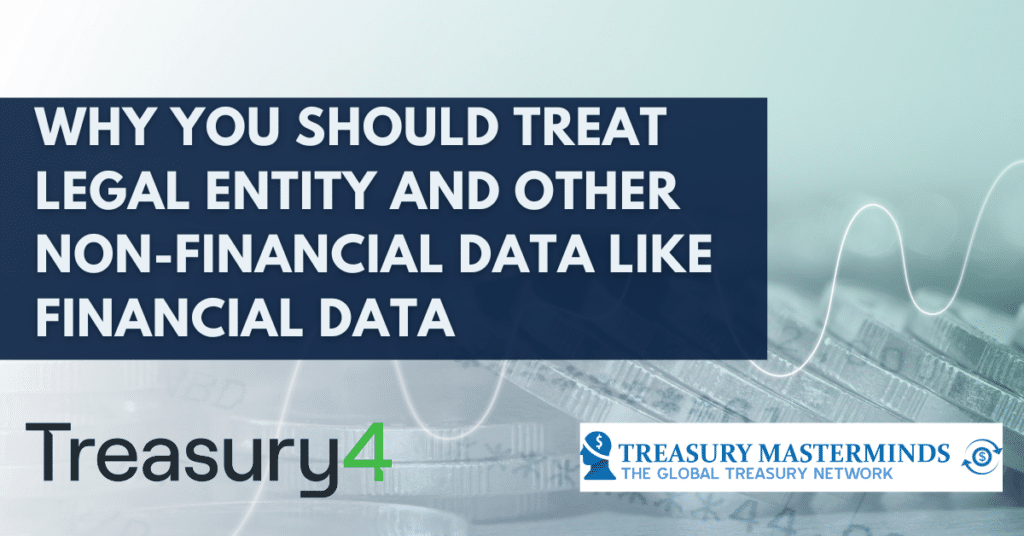
Why You Should Treat Legal Entity And Other Non-Financial Data Like Financial Data
This article is written by Treasury4 No two organizational structures are equal. Every organization has a distinctive legal entity structure. This can include parent entities, subsidiaries, partnerships, limited liability companies, joint ventures, and other related entities. It’s critical for key players to get a centralized view of this information to understand how their organization is structured—and how the various entities and financial accounts relate to and interact with each other. But that’s often easier said than done—particularly as organizations grow and become more complex. In many organizations, entity information is stored in numerous spreadsheets—but these static documents aren’t well equipped to handle the dynamic nature of corporate structures. Today, we’ll examine why you should reframe the way you think about your entity data – and why looking at it in the same way you look at your financial data – can be a game changer for your organization. Let’s start with why it’s time to say goodbye to spreadsheet-based entity management. Why Spreadsheet Tracking Falls Short Organizations are constantly changing—new entities are formed or acquired, others are dissolved, and key personnel come and go. A static spreadsheet can struggle to keep up with these changes; it requires manual data entry—leading to inefficiencies, errors, outdated data, and gaps in information. So, what should you do instead? A Financial Approach to Legal Entity and other Non-Financial Data One of the best ways to keep track of your organizational structure is to think of it the same way you would your financial data—and employ a similar system that can track transactions, activities and balances, both current and historical. You have your ERP to keep track of your financial transactions and balances, compare historical data, and drive decision-making. Having a similar tool to maintain a complete (and evolving) picture for your non-financial data is just as important. Take compliance, for example. Compliance is a moving target. New regulations and reporting requirements are introduced regularly—and companies must adapt quickly. That means having systems in place that can track and manage compliance-related information, like tax identification numbers, registration renewals, filing deadlines, FBAR reporting and more. Without a structured database and reporting, it’s much more difficult to find and update necessary data. You need a standardized system that puts all the necessary data at your fingertips. That way, you can make sure you have all your ducks in a row to stay compliant. And compliance isn’t the only consideration. This fuller picture of your data also allows you to compare historical data points, relay critical information to key stakeholders, get clearer insights, and make more informed and strategic decisions. The question is what system should you use? How a modern, Entity-based TMS can help your Entity Management Process When you think of a TMS, you probably think of a tool that tracks your cash holdings and transactions. But Treasury4’s platform can help you with entity management, as well—and give you a dynamic, comprehensive picture of your entire organization. This not only allows treasurers to track financial data, but it also enables other departments, such as legal and tax, to access and manage the information they need. By keeping all this data in a single, central repository, organizations can ensure that all stakeholders have a clear, full view of the company’s health across the board. Centralizing non-financial data allows owners to update the data in a single location and stakeholders to be able to refer to and utilize that data with confidence. In today’s rapidly evolving business and technology landscape, it’s also important to consider what your data needs will look like down the line. Put simply, your TMS and entity management system should also be able to easily adapt to future changes. For example, carbon reporting and climate-related regulations are likely to become increasingly important in the years to come. Where will that information be maintained? You’ll need to be able to track these new requirements and integrate them into your compliance management processes. Another example: Data is already a driving force of business success—and it will only become more valuable as time goes on. The ability to ingest, process, and analyze data quickly will be a key competitive advantage. Machine learning and AI will play a vital role in the future of data collection and analysis. Leveraging these cutting-edge technologies will be critical in helping you gain meaningful insights, improve the accuracy and speed of your reporting, and identify emerging trends. But the effectiveness of these tools depends on the quality of the underlying data. By implementing a system that standardizes and consolidates data—both financial and non-financial—you can ensure you have a solid foundation for data-driven decision-making. Consolidate, Curate, and Understand your legal Entity and Non-Financial Data Treasury management is no longer just about tracking cash flows and managing bank accounts. It’s about gaining a 360-degree, centralized view of an organization’s overall structure and health, ensuring compliance, and leveraging data to drive strategic decisions. The companies that rise to the top will be those that embrace a comprehensive and collaborative approach that integrates cash management, entity management, and cutting-edge technology. If you’re still relying on spreadsheets to manage and track your corporate operations, it’s time to consider a change. Spreadsheets are limited in their ability to provide a comprehensive view of an organization. And spreadsheets lack the easy visibility needed to go back in time and answer historical questions about non-financial data. They are also prone to errors, difficult to update, and lack the collaborative features needed in today’s fast-paced, dynamic business environment. A modern entity management system like Entity4 is a much better alternative. By providing a 360-degree, centralized view of the organization, Entity4 allows companies to manage critical operational information across departments, gain deeper insights, and make more informed decisions. Also Read Join our Treasury Community Treasury Masterminds is a community of professionals working in treasury management or those interested in learning more about various topics related to treasury management, including cash management, foreign exchange management, and payments. To register and connect with Treasury professionals, click [HERE] or fill out the form below. Notice:…